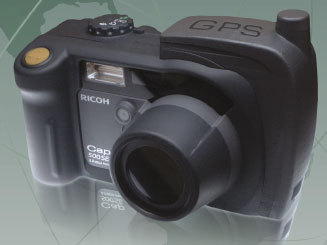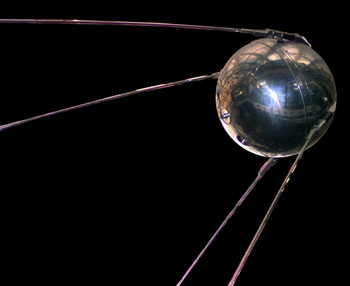This was January 2007 | « December 2006 | Main | February 2007 »
Space Arms Race, Here we Come!
Posted on Wednesday, January 31, 2007
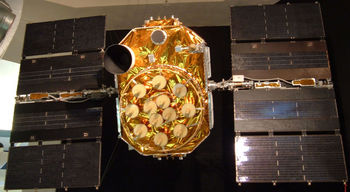
Click to enlarge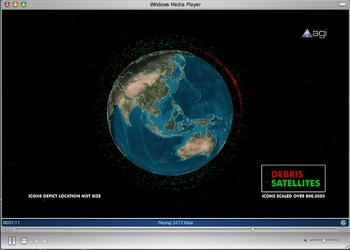
Click to enlarge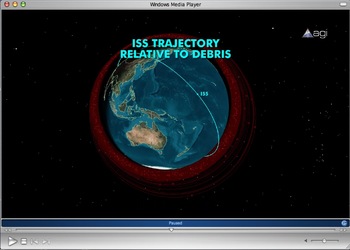
Click to enlarge
[Update Friday 2nd Feb 02:00 CET: The new space race has apparently already started. More news, including a STK visualisation of the debris cloud resulting from the kinetic kill, at AGI's Center for Space Standards & Innovation (CSSI) (via Spaceports blog)]
Excellent title of this space blog entry at the Lifeboat Foundation, following the Chinese Anti Satellite (ASAT) weapons test earlier this month:
Space Arms Race, Here we Come!It’s true - when one nation moves into space weapons, others are forced to follow just to keep up. It’s the Red Queen scenario, where you have to keep moving forward just to stay in the same place. Because preventing the weaponization of space is likely impossible, it looks like we will have to come to terms with it. One beneficial side effect of a space weapons could be the development of better space systems in general, which could eventually be used to create autonomous colonies.
The latter could actually be true. If so, what could be the emerging technologies out of this new weapons race, or out of the upcoming peaceful Moon race variant as described in this 2004 Space.com article:
Strategic target“The moon is the first step beyond low Earth orbit that any spacefaring nation is going to try to master,” said Mike Duke, a geologist at the Colorado School of Mines in Golden, Colo. The Europeans have passed that mark, he added, so their lunar missions are described as technology demonstrations.
Meanwhile, the Japanese are trying to display their technical prowess in instrumentation. “They need to demonstrate a reasonable launch capability to be considered a player in that arena. They’ve had some problems, so maybe the lunar mission is a driver to keep the rocket folks focused,” Duke said.
Duke said China and India have arrived at a place in their development where they can do lunar missions and gain in stature among spacefaring nations.
“I’m afraid that I don’t see that any of these really involve the moon as a strategic target for exploration, though everyone is looking for that strategic handle,” Duke said.
“I'm not sure what to make of it all in the grand scheme of things,” said Paul Spudis, a planetary scientist at the The Johns Hopkins University Applied Physics Laboratory (APL) in Laurel, Maryland.
A number of factors are stirring multi-nation lunar interests, Spudis said. For starters, in the quest to get beyond low Earth orbit, the moon is an easy first target. Then there’s the idea that, somehow, the moon’s history is intimately tied to that of the Earth. Lastly, there is the simultaneous emergence of space capabilities among industrialized countries, as well as coincidence.
“Which predominates? I’m not sure,” Spudis said. “I’d like to think that there is emerging recognition of the strategic value of the moon. But although I do think that is present, it’s not the principal driver,” said Spudis, who was a member of the President’s Commission on Implementation of United States Space Exploration Policy, which advised the White House on how best to move forward on a moon, Mars, and beyond human and robotic exploration strategy.
“In fact, as far as the [Bush] Administration goes, it is the principal driver of the vision, not a human Mars mission … in contradistinction [contradiction] to the intense belief of many who work at NASA,” he said.
Pointing to several nations that are hammering out lunar exploration plans, Spudis said he senses that India’s program is an attempt to promote space science and technology, and demonstrate that they are, indeed, a 21st century, industrial nation. China has similar goals, he said, but is focused more on servicing their “international inferiority complex” to help underscore “that they too are a great nation.”
The emerging technologies from some earlier military involvement in space included what...V2? Sputnik? microprocessors (as discussed in an earlier post)? Keyhole (aka Keyhole)? GPS? Its probably a bit too early to discuss now, but I can see it become part of this conference in the future.
Btw, I am curious to see the trajectory of the Chinese interceptor in Google Earth, anyone has a line to the Chinese military?...the American military perhaps? If so, drop me a note or leave a comment!
Communications & travel
Posted on Wednesday, January 31, 2007
From an interesting piece by Clay Shirky:
Jaron Lanier is the Charles Babbage of Our GenerationHere we arrive at the furthest shores of speculation. One of the basic promises of virtual reality, at least in its Snow Crash-inflected version, is that we will be able to re-create the full sense of being in someone's presence in a mediated environment. This has been a human desire at least since Shamash appeared to Gilgamesh in a dream. Re-stated in technological terms, this version of virtual reality is a belief that communications will finally become an adequate substitute for travel. We have been promised that this will soon be achieved with current technology since ATT demoed a video phone at the 1964 World's Fair.
I believe this version of virtual reality will in fact come to pass, someday. I do not, however, believe that it will involve a screen. Trying to trick the brain by tricking the eyes is a mug's game. The brain is richly arrayed with tools to detect and unmask visual trickery -- if the eyes are misreporting, the brain falls back on other externally focussed senses like touch and smell, or internally focussed ones like balance and proprioception.
Though the conception of virtual reality is clear, the technologies we have today are inadequate to the task. In the same way that the theory of computation arose in the mechanical age, but had to wait first for electrics and then electronics to be fully realized, general purpose virtual reality is an idea waiting on a technology, and specifically on neural interface, which will allow us to trick the brain by tricking the brain. (The neural interface in turn waits on trifling details like an explanation of consciousness.)
In the meantime, the 3D worlds program in the next decade is likely to resemble the AI program in the last century, where early optimism about rapid progress on general frameworks gave way to disconnected research topics (machine vision, natural language processing) and 'toy worlds' environments. We will continue to see valuable but specific uses for immersive environments, from flight training and architectural flythroughs to pain relief for burn victims and treatment for acrophobia. These are all indisputably good things, but they are not themselves general, and more importantly don't suggest rapid progress on generality. As a result, games will continue to dominate the list of well-populated environments for the foreseeable future, rendering ineffectual the category of virtual worlds, and, critically, many of the predictions being attached thereunto.
Space & the Internet
Posted on Sunday, January 28, 2007
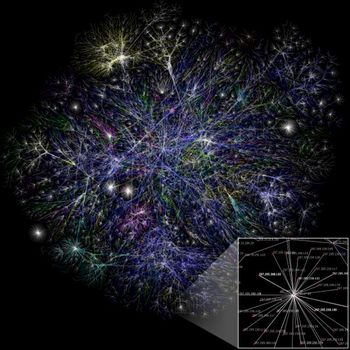
NASA Administrator Michael Griffin is picking up steam in his speeches he is delivering all around the US and abroad on NASA's plans for the future. Here are two of his recent talks, one in Houston Texas, and one at the World Economic Forum in Davos, Switserland. In the latter, I found a quote which resonates with a topic I am starting to get more and more curious about:
I am sure that many of you would agree with me that the greatest revolution in our productivity and way of life has been the development of the personal computer, internet and various handheld communication devices. Thirty-five years ago, engineers like me used three pieces of wood and a piece of plastic that moved -- the slide rule -- to make calculations. Thirty years ago, 1,000 transistors could fit on a silicon chip; today, it's 100 million. The cost of such chips has dropped by a factor of 100,000. Few people know that the development of the first microprocessors was born of a competition between Fairchild and Intel in the 1960s, to build components small enough to fit in NASA spacecraft. This straightforward NASA technical requirement spawned a whole new industry that grew in ways few, except perhaps Gordon Moore, could predict. Necessity is the mother of invention, and I believe that we are at our most creative when we embark on bold ventures like the space program.
The main point here is the relationship between the space endevour and the origins of the chip industry. With this year's 50th anniversary of the first satellite in orbit (Sputnik), it seems the most influential societal outcome of space exploration sofar has been the rise of the computer. I more and more like the term 'emerging technologies' in this respect. On a side note, the launch of Sputnik also stirred the creation of the US 'Advanced Research Project Agency (ARPA)', which later during the Apollo days set up the precursor of the Internet known as ARPANET. I am interested to find out if there has been some more indepth study into this relationship.
Just in: Google's virtual world
Posted on Thursday, January 25, 2007
Update: seems this meme touches a nerve, cause it is spreading to where I normally don't see any discussions on Google Earth or Second life, such as the blog by John Battelle.
The rumor continues...Google's Metaverse (via Google Earth Blog). Best comment sofar by Tom Churn:
If you work in this industry, you’re already living in Google’s Virtual World. At least, for about 10 hours a day…
As always, Brownian Emotion has an interesting perspective on things, like:
Rumors persist that Google is in the process of turning Google Earth into a virtual world. Well, I hate to burst anyone’s bubble, but GE already is a virtual world. It’s a virtual earth. It has all of the features of a virtual world (spatiality, point of view, presence, information modeling), minus a few we’ve come to expect from a game or socially-oriented space (seeing yourself, seeing other people, and directly interacting togther).
Reading his post, I was thinking the same thing as I just read on OgleEarth: it maybe so that for planet Earth Google Earth is a mirror world and not a virtual one, but what about all those other worlds out there? What about Mars for example? Is there any (evolutionary?) logic in allowing people to build a virtual world ontop of Mars imagery...I mean...no one is going to get there anytime soon except for some robotic explorers, so apart from the imagery, there is not really the chance of mixing up the 'real' world with a customly-designed virtual one. The only question is: what is the added value of building a virtual world as a mashup on another planet, instead of creating a completely user-generated SL type of virtual world?
Google Earth Panorama Viewer
Posted on Thursday, January 25, 2007
One more thingGUI: the Google Earth Panorama Viewer. This one is definitely here to stay and evolve to even more immersiveness. Its beautiful, even in its current 'crude' state. Created by Digital Urban, it has been making quite some furore in the blogosphere (like OgleEarth, Google Earth Blog and MAKE blog). Check out the above video (I am not so sure about the music...you might wanna turn it off ;-) and have a look at this tutorial and some other panoramas at the Digital Urban blog.
It ties in with the Gigapan camera project I learned about while over at NASA Ames last year in combination with Brownian Emotion discussing a possible next step for Google Earth, where these panoramas would be viewed not outside Google's Earth as a separate sphere but inside of it :
As a exercise, imagine yourself inside the Google Earth, assuming it’s hollow and the imagery you usually see sits on a thin glass shell that can be viewed from inside as well as outside the Earth. If you’re in the center of the sphere, what you’re seeing is essentially the same as a virtual panorama. The same mouse controls that let you spin the Earth now let you spin the panorama from the inside, grabbing that shell like you’d grab the ground. The main difference between this and flying up above the Earth, apart from the imagery and the source, is just the point of view of the observer.
Jeff Han's multi touch
Posted on Thursday, January 25, 2007
Its been around for a while already (in Internet terms that means what, a couple of days?), but for those of you who haven't seen it: a new video showing the next generation multi touch screen (via OgleEarth amongst others). Here is the article that goes with it.
Gibson on space travel
Posted on Thursday, January 25, 2007
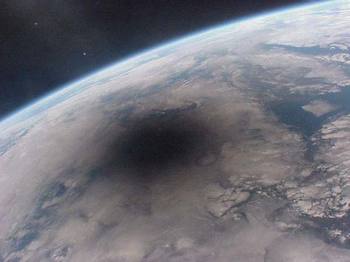
If the ideas of contemporary science fiction writers is anything to go by, here is an interesting interview with William Gibson from back in 1999, where amongst other things, he says the following:
While we were dreaming about spreading our chromosomes, the species was spinning this prosthetic nervous system for itself, and that's what's driving social change now. It's not legislation, it's not population pressures. Where we're going is the result of emerging technologies, and that's terribly rich ground for a science fiction writer.The above image of a Solar eclipse as seen from space is one of the last images made from the MIR station before it was brought down in 2001. In the interview, Gibson specifically refers to it, saying:
I was really deeply moved by one of the last photographs to come out of that station, an image of the Earth seen during the solar eclipse. I thought to myself, "we've never had that camera angle before.
Btw, if the space.com website is any hint at what the main internet portal to outer space will be like (its one of the more popular space related websites at the moment I believe), there is still lots of work to be done...the design is just...well...terrible...!
Project Excelsior
Posted on Sunday, January 21, 2007
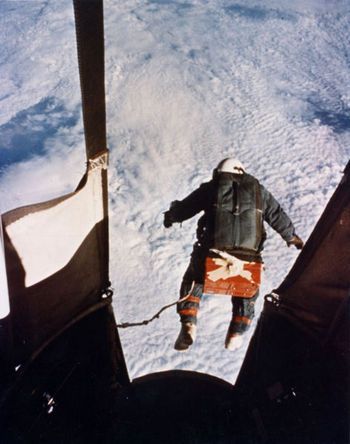
Too bad Joseph Kittinger wasn't carrying a GPS device at the time he jumped out of his balloon carriage back in 1960 (GPS, 1960?). Would be interesting to see his jump in Google Earth. Kind of a space tourism 0.1. Just saw his footage in a clip from Boards of Canada.
Highly relevant ads
Posted on Sunday, January 21, 2007
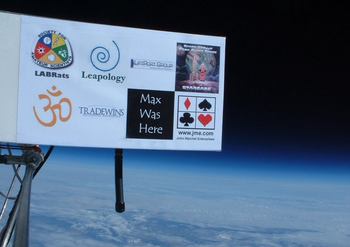
Click to enlarge
Following news on Google's possible acquirement of an in-game advertising firm (first read on OgleEarth), I finally found a reason to upload this image on advertisements in space...When will Google's next ad frontier (WSJ subscription) coincide with the final frontier, either real or virtual? Is there really anything against serving highly relevant ads once people start returning to the Moon? And would it be able to support some good space exploration initiatives? Or even better, some new Earth Observation missions following the warning from the US National Academy of Sciences that the US is underfunding its EO capabilities in the years to come (WSJ editorial: blinding ourselves in space). Its basically in our own interest to have these missions, so why not fund them through Google Adsense...
Tobedetermined finds...Agents of Evolution
Posted on Wednesday, January 17, 2007
- Futurist Peter Schwartz introduces an interesting term new to me in this article: Agents of Evolution
- O'Reilly Radar: Measuring a virtual world and If Google were a restaurant
- How about one of the above cameras onboard the ISS?
- Back to the 50's: China destroys old weather satellite
- Google wants YOU! in Google Earth: Google's Australia Day 2007 aerial photography. Turns out, Microsoft is planning to do the same, with the oh, so Microsofty catchphrase 'Look Up and Smile this Australia Day'
- The archives: Google's Master Plan
Geostationary playground
Posted on Tuesday, January 16, 2007
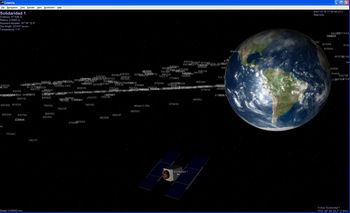
Click to enlarge
Thinking about how 3 dimensional outer space could be represented inside virtual globe environments, I spent some time flying around the Solar System in Celestia. Incorporating some of the satellite plugins available at the Celestia Motherlode, I managed to get the Geostationary ring become visible with all its +100 telecommunication satellites. The nice thing about Celestia is that it allows you to lock onto any object you happen to pass by, so zooming into the individual satellites now visible, I circled the Earth by hopping from one satellite to the next. Funny enough, it actually did gave me a feel of being 'out there', looking down at the Earth from 35,786 km altitude.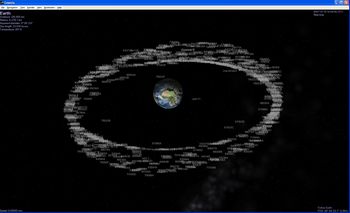
Click to enlarge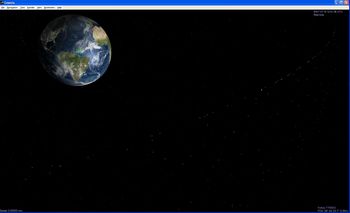
Click to enlarge
tobedetermined finds...
Posted on Monday, January 15, 2007
- Pasta & Vinegar posts on two Google Earth related stories which somehow seem related: (1) using Google Earth as a game interface (following this article on the game site Gamasutra), and (2) Google Earth and the roadmap to the metaverse (based on this story on CNN's Business2.0)
- The End of Cyberspace blog: Second Life avatar consumes as much electricity as a Brazilian
- Not only is 2007 the 50th anniversary of the launch of the first artificial satellite Sputnik, its also the 100th anniversary of Sergey Korolyov, Russia's key designer during the Space Race
- Asimo at CES2007
Google Earth used by terrorists?
Posted on Monday, January 15, 2007
update 16 january: the debate continues at OgleEarth (also check out the comments on the previous post)
OgleEarth has a throughly investigated post on an article appearing in UK's Daily Telegraph.
10 years later: MRO pinpoints Mars Pathfinder
Posted on Friday, January 12, 2007
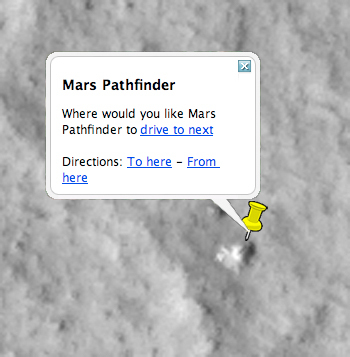
NASA's Mars Pathfinder landed on Mars on July 4, 1997. Just under 10 years later, Mars Reconnaissance Orbiter (MRO) returns to what I recall as the web1.0 highlight of the ongoing merger between outer space and cyberspace. With its Google Earth look-from-above feel, I can hardly wait till this image is Mars-referenced available in Google Mars. More images and stories available at NASA's Mars Pathfinder Landing Site and Surroundings.
click to enlarge
Google's Earth anno 2007
Posted on Friday, January 12, 2007
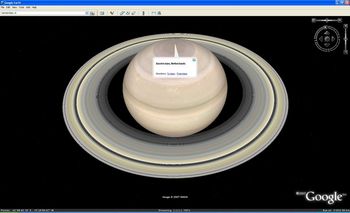
Click to enlarge
Mmm, seems global warming really started kicking in last year (via GEB).
Google Earth zeitgeist
Posted on Friday, January 12, 2007
How about a Google Earth zeitgeist, served to you as a kml overlay, or, while we're at it, why not as a dedicated layer inside GE? One where we get to see the most popular places looked at in Google Earth, categorised by lat/lon, altitude and some other specifics? One advantage: there is no need to filter out such terms as sex and alike.
Another idea I just had, how about airlines providing GE-ready GPS trails of the flight you just got off from. You provide your email address while on the plane, and once you land its automatically send to your email box. Nice for some post-flight recollection of what exactly you saw in that twilight zone state when you opened your eyes those 5 seconds and looked out the window before finding another 'comfortable' position to fall back to sleep in. This happened to me on a flight to San Francisco last year where I have vague memories of seeing polar bears fly next to the plane when we passed over the American continent half way up the artic.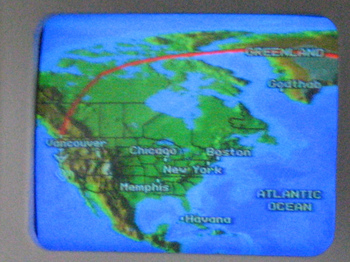
A live flight tracking is already available.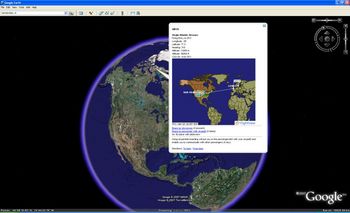
Click to enlarge
With a GPS trail, it could look something like GoogleEarthBlog's trip back from Las Cruces.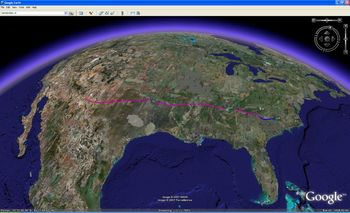
Click to enlarge
yep...the iPhone
Posted on Wednesday, January 10, 2007

Finally a decent iPod phone...time to put my p990i away (after 1 month of agony already)...oh wait, its only available Q4 here in Europe...June in the States...guess its time to go back ;)
tobedetermined finds...
Posted on Monday, January 8, 2007
- Just in: Google teams up with a large group of universities, research institutions and private companies to become the archival experts for the Large Synoptic Survey Telescope (via OgleEarth). Makes sense to me ;)
- Backlog: OgleEarth shares some interesting reflections in this post on the possibilities following December's collaboration announcement between Google and NASA.
- This year is the 50th anniversary of the launch of the first articificial satellite Sputnik in October 4th 1957 (Listen to the sound of Sputnik as it passed over in those days). This weekend's M special of the Dutch newspaper NRC handelsblad is all about the Internet. Their introduction (my translation):
1 billion Earthlings connected to the Internet
50 years ago the Russians launched their Sputnik. The Americans got scared shitless and developed an invulnerable military information network which saw the birth of the Internet. Today, the net belongs to the massess. - ESA news: First 3D map of the Universe's dark matter scaffolding
- Google Earth Blog has the story of a French company Pict'Earth offering a remote control plane with camera capturing realtime images for Google Earth. OgleEarth picked up the story and expands on it
- Webcasts are available from the 2nd Space Exploration Conference in Houston 4-6 December last year. Unfortunately they're coded in Realplayer, so no offline viewing/listening
Navigating outer space
Posted on Friday, January 5, 2007
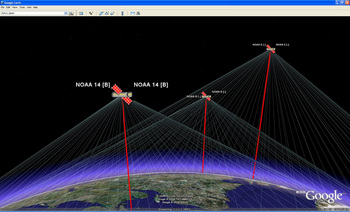
Click to enlarge
Update monday 8 January: I have edited most of below text yesterday after originally posting it on saturday evening. Reading through it again, I noticed how it touches upon a relevant aspect for me of the mediation of outer space through cyberspace: the interface to the planets and 3 dimensional outer space. This post might well be the start of a longer text on this topic.
As you probably noticed, I've been mostly away from the blogosphere the last 2 weeks, spending some enjoyable 1st life here in Amsterdam. As a result, I am now looking at a backlog of ideas, thoughts and interesting stuff out on the web related to this blog's topic which I hope to post about in the coming days & weeks (and a happy new year to all of you of course!). First on my list:
The SpaceNavigator™
I received mine from Germany earlier this week and it turned out even better than I expected. It really is an excellent tool for flying around and 'travelling' in Google Earth. For more indepth reviews of the device, see OgleEarth and GEB.
Using it brings back memories of when I was studying in Delft. It must have been around 1995 when I took a course in 3D modeling and virtual reality. At the time, I was heavily into all things cinema and especially Andrei Tarkovsky, so as part of the VR course I set out to model the cathedral from the final scene of his movie 'Nostalgia'...it was only a test case, and I unfortunately never finished it (the course was over before I could), but during the course I got my first flying lessons in virtual spaceland using one of these nifty interfaces (at that time they were called space mouse). I remember the pleasure of navigating with 6 degrees of freedom through 3 dimensional space, flying through my half finished cathedral. Using the SpaceNavigator now allows me to do (almost) the same stunts in Google Earth. Its a bit like I imagine real life cessna flying could be like if you do not live right under the ![]() airspace of one of Europe's major airports Schiphol.
airspace of one of Europe's major airports Schiphol.
The biggest surprise after firing up Google Earth with my new SpaceNavigator came from the possibility to look up, to look at the stars, away from the Earth, something which with normal keyboard navigation I never managed to do. Suddenly Google Space starts to make a lot more practical sense. Its like what Micheal T Jones (Google Earth CTO) talked about in his Google Earth talk a year ago, where he, refering to work by Tjalling Koopmans, discusses how we as humans are shaped by our tools (as in 'the medium is the message' by Marshall McLuhan).
Below image is one such example of a Google Earth view I never managed to get before my SpaceNavigator arrived (the Earth is somewhere below the screen). And I like the way Windows confirms plugging in my SpaceNavigator with "Found new hardware: USB human interface device" ;)).
Having been stuck with the Earth-centric view in all of todays digital globes out there (and/or Moon/Mars centric in the case of WorldWind), the opportunity to look away made me wish for more. I for one would like to navigate through outer space in Google Earth, to turn around and head for the Moon. Sofar, releasing my SpaceNavigator makes me instantly flip back to the Earth, as if my sticky eyeballs are glued to it.
I have seen navigating through 3 dimensional 'outer space' in Celestia, an open-source 3 dimensional space simulation available for free on the web. During the holidays, I played around with it again after seeing it on a big screen at the NASA Ames exploration Center last November where it was used to explain to the audience about the solar system and beyond. The interface is somewhat different from Google Earth and the others, but once you get the hang of it, its really enjoyable to navigate through the Solar System, have a close up view of the Jupiter moon system, take a warp drive outside our own galaxy and safely return back to our 'default' Earth.
tobecontinued...
Click to enlarge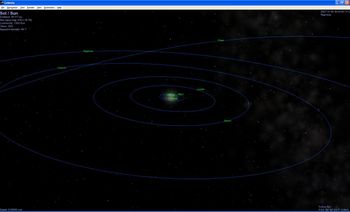
Click to enlarge
The future is process, not a destination
Bruce Sterling
Everything is ultimately becoming information technology
Ray Kurzweil
Data is the Intel inside
Tim O'Reilly
There is only one machine and the web is its OS
Kevin Kelly
The medium is the message
Marshall McLuhan
